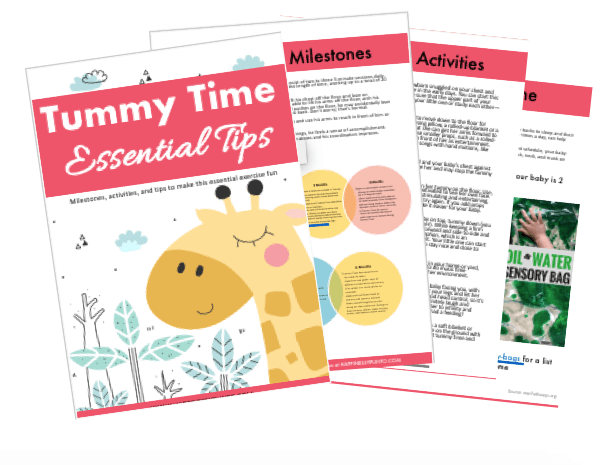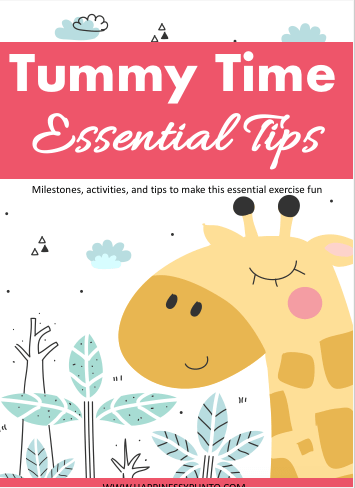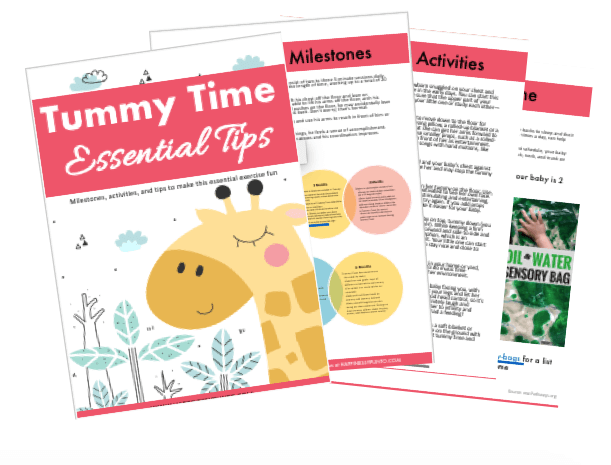After so many hours spent sleeping on their backs, babies need to practice using their neck muscles.
Learn the basics of this crucial activity, including when to start tummy time, milestones, fun positions, and tummy time projects you can do to make tummy time more fun!
No time? Pin it and read it later

Tummy Time Milestones
- In the beginning, newborn tummy time should consist of two to three 3-minute sessions daily. As he gets older and stronger, gradually increase the length of time, working up to a total of 20 minutes a day.
- By about 4 months, your baby should be able to lift his chest off the floor and lean on his elbows with his head upright. He may even be able to lift his arms off the floor, arch his back, and kick his feet. As your baby stretches and pushes on the floor, he may accidentally lean to one side, fall over, and roll from his belly onto his back. Don’t worry; that’s normal.
- At 5 or 6 months, he will begin to pivot on his belly and use his arms to reach in front of him or to the sides.
- When your baby learns to make his body do new things, he feels a sense of accomplishment. This gives him the confidence to try new skills as he grows and his coordination improves
Download the Tummy Time essential Guide at the bottom of this post of a breakdown of milestones by month.

Tummy Time Tips and Activities
Go chest to chest
Relaxing against some couch pillows with your newborn snuggled on your chest and looking at your face actually counts as tummy time in the early days. You can start this activity (and bonding time!) on day one. Just make sure that the upper part of your body is at a 45-degree angle. Now you can chat to your little one or study each other—you’re both getting to know each other after all.
Use props to help you
When your baby is two or three weeks old, it’s time to move down to the floor for tummy time. “Put your baby’s chest against your nursing pillow, a rolled-up blanket or a beach towel, again at a 30- to 45-degree angle, so that she can get her arms forward to start to brace herself,” says Halfin. As time goes on, use smaller props, such as a rolled-up kitchen towel. Place a book, toy or even yourself in front of her as entertainment. Now is a great time to break out your favorite nursery songs with hand motions, like patty-cake.
Have a seat
You can also sit on the floor with your legs outstretched and your baby’s chest against your legs. Talk, sing and rub her back—it will help soothe her and may stop the tummy time tears.
Be entertaining
Once your baby is three or four months old, she can be on her tummy on the floor. Use, a small mirror at a 45-degree angle so that your baby is motivated to see her own face. Any sort of pattern, especially black and white, is visually stimulating and entertaining, too. If your baby becomes tired or cranky, take breaks and try again. If you add props prop, like a blanket, a toy, or sensory bag it will help to make it easier for your baby.
Rock and roll
Get out your exercise ball or a beach ball and place your baby on top, tummy down (you may want to place a blanket on the ball to make it cozy for her). While keeping a firm hand on her so that she doesn’t slip, gently roll backward, forward and side to side and even bounce a little. This move helps baby develop proprioception, which is an awareness of where her body is in relation to her environment. Your little one can start this tummy time activity shortly after birth—just make sure to stay nice and close to your baby.
Take a stroll
Cradle your baby in your arms, tummy down, and go for a walk in your home or yard, describing what you see along the way. This is a great position to do music time together. This is also a great way for her to start learning about her environment.
Make a baby airplane
Lie on your back with your knees up to your chest and hold your baby facing you, with her little body on your shins. Hold her chest to secure her against your legs and let her arms rest on your legs. This activity requires your baby to have good head control, so it’s best to wait until she is about two or three months old. She’ll definitely laugh and giggle at this one as you make airplane sounds and pretend to fly her to infinity and beyond. Spit-up alert: This one is best when your baby hasn’t just had a feeding!
Practice During Diaper Change
Before you put on a clean diaper after a change, place your baby on a soft blanket or towel on the floor. Let her stare and play with a stuffed animal, or lie on the ground with her and make funny faces. The best thing about this activity? You get tummy time and bare bum time at the same time, which is a serious parenting win!
Print out this guide to reference it as you practice these tummy Time Tips

Already a member? go to the digital library to access this download – you will need the password – check your welcome email – it’s in there
Want more activities? check out all these tummy time sensory bag ideas to make tummy time for fun

1 thought on “The Best Tummy Time Techniques (and what to do if your baby hates it)”
Comments are closed.